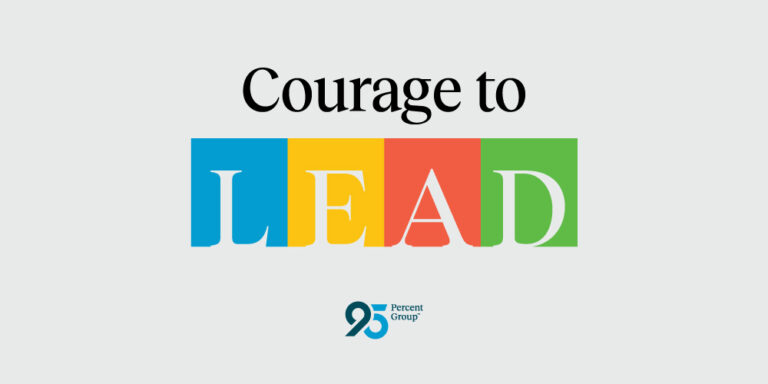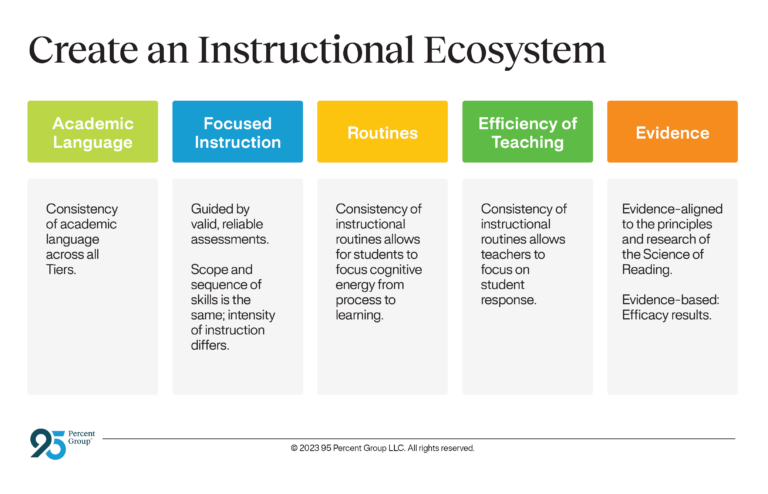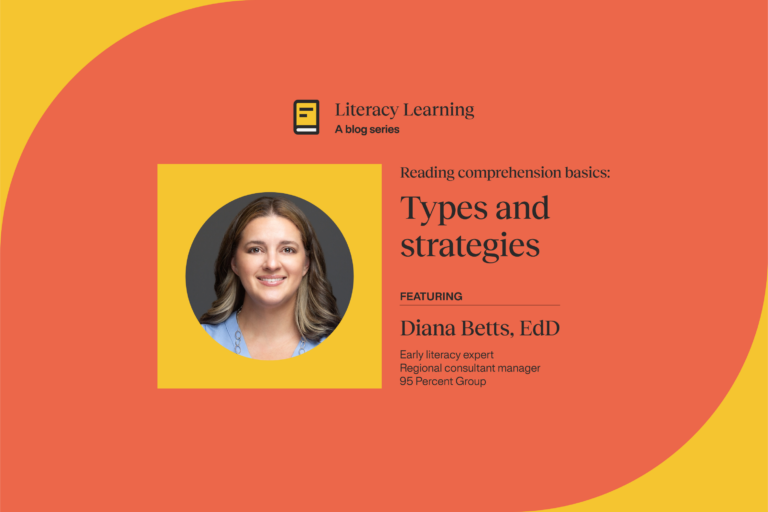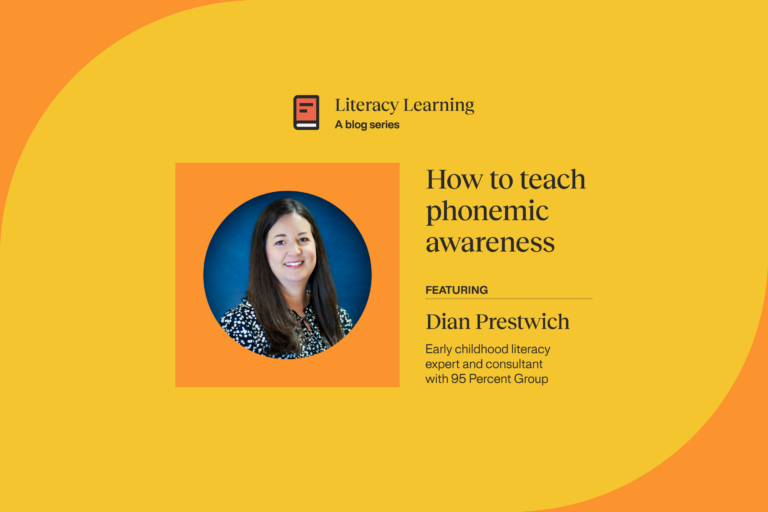The courage to lead: 10 bold moves for transformational change
The first priority in leading transformative change in literacy is to create a team of diverse and invested parties to ask those big questions and take those bold steps. These are ten bold steps and big questions for a leader to consider.

Laura Stewart, Chief Academic Officer at 95 Percent Group, has worked with numerous districts over decades and knows what it takes to bring transformative change to unlock the power of literacy for all students. This year she is sharing her unique expertise and spotlighting case studies in successful change through a regular webinar series featuring candid discussions with literacy changemakers. She will also share in-depth insights and best practices through regular editorial contributions. Following is her first contribution to kick off this special effort to empower the next generation of lifelong readers and learners.
Many educational leaders are grappling with their role in bringing the science of reading to their schools or districts. Even with the myriad responsibilities an administrator has, leading the literacy charge is the most important work to be done. Ensuring all students achieve high levels of literacy is the promise we make to our families and our communities.
Where does a leader begin? Let’s frame this around the idea that bringing the science of reading to a school or district will likely require transformative change, rather than transactional change. What is the difference? Transactional change refers to a change that maintains the existing structure and does not fundamentally alter the way things are done. Transformative change, on the other hand, involves a fundamental shift in the way things are done and the structures that exist. It is more radical and far-reaching than transactional change, and often involves a change in values, beliefs, and assumptions.
The leader’s first priority in leading transformative change in literacy is to create a team of diverse and invested parties to ask those big questions and take those bold steps. Below are ten bold steps and big questions for a leader to consider as they bring transformational change:
Bold step #1: Raise awareness
Big Question: What is the percentage of students reading at or above grade level in our school or district?
This question can be uncomfortable, but until we have a shared awareness of the gap between where we are and where we can and want to be, there will be no sense of urgency. A key principle from the science of reading research is that instruction matters, and it is clear that after high-quality, evidence-aligned instruction, the percentage of first graders below 30th percentile can be reduced to 4–6%. In other words, 95 percent or more of our students can learn to read, and read well, with the right instruction at the right time (Foorman, Breier, & Fletcher, 2003; Mathes, et al., 2005; Torgesen, 2004 & 2005).
It is important to emphasize that when we are not reaching our shared goal of literacy for all, it is not about blame; it is about a leader bringing awareness to the school community that there is a gap between where we are and where we could be, and that gap creates the space for transformative change.
Bold step #2: Think about the big picture
Big question: What do we want our students to know and do?
This seems obvious. Aren’t our state standards, our curriculum guides, our scope and sequences designed to answer this question? Surprisingly, there is sometimes a lack of transparency in this area; not all invested parties may be united in the big picture of literacy.
An initial exercise is to examine current standards, guidelines, and curricula to ensure that they are truly aligned in what we want to accomplish in the big picture of literacy. If we keep that big picture as our “north star,” it helps us discern what to keep and what to abandon (more on that with steps 7 and 8).
Bold step #3: Assess and monitor
Big Question: How will we measure success?
There are many different assessment instruments to choose from. One of the challenges I have heard from teachers is that they feel they are being provided with too many assessments taking up valuable instructional time. How do we know which tools to use? First of all, we need to determine what data we really require and what valid and reliable assessments can provide us with that data. A solid resource for exploring these tools can be found here: Academic Screening Tools Chart (intensiveintervention.org).
What about measuring growth? Sometimes we are prone to celebrating incremental success, and that is not wrong. We simply need to be in agreement that “better” is not the goal. When we think about our universal screeners, it is important that we have time to really look at the data and ensure it is not only moving in the right direction, but that we will not rest until we achieve our goal that ALL of our students are reading at proficient levels or above.
Bold step #4: Start with Tier 1
Big Question: Is Tier 1 instruction meeting the needs of at least 80% of our students?
Tier 1 is designed to be exemplary core, grade-level, first instruction for all students, while Tiers 2 and 3 are designed to provide additional time, intensity, and focus of instruction for subgroups of those students. Tiers 2 and 3 are not replacement, they are additive to Tier 1. When our universal data reveals that we have that many students in intervention, it is important that we examine what is happening in Tier 1 instruction. We want to closely examine the universal screening data to uncover weaknesses in Tier 1 instruction and instructional materials to think about how we can improve Tier 1 instruction to prevent students from needing intervention. It is mandatory that Tier 1 instruction and instructional materials be evidence-aligned (aligned with the research base of the science of reading), and ideally, evidence-based (with efficacy studies to show the methodology and how materials work).
Bold step #5: Plan intervention
Big question: What do we do if they don’t learn in Tier 1 instruction?
Yes, there will be students who need additional time, intensity of instruction, and focus of instruction. How do we ensure that our intervention plans are accurate?
What features are necessary to call out as we plan intervention?
- Do we have the right instruction and instructional materials in Tier 1?
- Are our screeners providing us with useful data?
- From screening, are we administering diagnostic data that identifies the specific gap area to be addressed? (Screening identifies WHO, diagnostic identifies WHAT and WHY.)
- Are we progress monitoring frequently (every 1–3 weeks) to ensure that our students are not caught up in the “cul-de-sac” of intervention?
Assessment data and precise instruction are KEY to this bold step; through targeted, focused intervention we CAN accelerate students into Tier 1 instruction.
Bold step #6: Plan enrichment
Big Question: How will we extend learning for those who need it?
While much of our attention is focused on intervention for students below benchmark, it is important to acknowledge that we have students who are identified as performing above benchmark. “Intervention” really does apply to intervening with students who need additional enrichment or extended learning.
Bold step #7: Take inventory
Big Question: What are we doing now and how does it align with the evidence?
A sometimes difficult but incredibly eye-opening exercise is to list every curriculum resource and instructional practice in use to determine if it has an evidence base. For example, many districts still carve out “DEAR” (Drop Everything and Read) time during the school day. There is little evidence to support that practice, and in fact DEAR may take away valuable time from more impactful, explicit instructional time. This can be a painful process because many of us in education have held on to practices we hold dear or materials we enjoy and feel confident in using. This is also difficult because much if not most of what we have used may have worked with many of our students. Taking inventory allows us to hold up evidence as a non-negotiable litmus test as we determine how we spend our precious and limited instructional time as we strive to impact not just many of our students, but all of our students. Taking inventory is a precursor to the next bold step.
Bold step # 8: Stop what’s not working to make room for what works
Big Question: What has to go, what has to stay, and what do we need to add?
There are only so many hours in the day. No educator looks at their lesson plans and declares “I just don’t know what to do with that pesky hour left in my day!” In comes ruthless prioritization. Once we have taken inventory, we have to take the big step of eliminating what is not serving us in order to make room for what is serving us or what can serve us.
One of the most promising ideas to explore is that of creating an instructional ecosystem. When the instruction and curriculum resources throughout our reading block are fully aligned and coherent across Tiers, within grade levels, and across grade levels, we can maximize time and energy to focus on what is working.
What are the attributes of an instructional ecosystem?
- Academic Language: The language used is consistent.
- Focused Instruction: Instruction is guided by valid, reliable assessments.
- Routines: There are high impact routines which can be taught to students that are replicable and scalable across grade levels and Tiers of instruction.
Finally, an instructional ecosystem should be evidence-aligned (aligned to the principles and research of the science of reading), and preferably evidence-based.

Bold step # 9: Build knowledge and practice
Big Question: Is the professional development consistent, provided for everyone, and based on existing knowledge?
While “empowering teachers with. . . appropriate knowledge. . .will change classroom practice” (Dehaene, 2017), many of us have faced a panoply of emotions when we realize we were not equipped with this appropriate knowledge in our teacher preparation programs. There is truly a grieving process that many educators go through when they reconcile the fact that their teaching practices were formed by ideas and theories that are actually now identified as misconceptions about how children learn to read, how instruction needs to look, and what to do if things don’t go as planned.
While building knowledge is a critical first step, we can’t stop there. In a recent review of research on professional learning (Hill & Papay, 2022), the authors identified that to truly strengthen teacher learning, the professional learning must:
- Focus on instruction practice rather than just content knowledge.
- Prioritize concrete materials for practice over general principles.
- Provide coaching to improve classroom instructional quality and student outcomes.
Bold step #10: Keep growing
Big Question: How are we building sustainability?
Our first step in growing and building sustainability is to truly grasp the enormity of the impact we have on student achievement. This responsibility creates a sense of urgency for leaders to:
- Ensure they are knowledgeable about the science of reading, not just in a general sense, but understanding the content.
- Seek out sources of information that can address our journey as literacy leaders in implementing the science of reading.
- Inspect what you expect. Seek out observation guides that can be used with teachers to set shared goals and expectations for the observable characteristics of evidence-aligned principles of instruction in classrooms.
And finally, we remember that this is a journey and every journey begins boldly.
Some final tips to consider:
- Start by forming a guiding coalition.
- Communicate relentlessly.
- Strive for progress, not perfection. We take bold steps, we learn, we pivot, we keep going.
- Take the next best step. Hopefully these big questions and bold steps will help you think about your priorities so you can reach your goal of literacy for ALL. One step at a time.
Register now: Courageous leaders webinar series!
Join Laura Stewart, Chief Academic Officer, as she introduces Courageous Leaders, a transformative webinar series featuring insightful discussions with prominent literacy changemakers. Whether you’re a practiced literacy leader or newly aspiring to these roles, our thought leadership sessions will provide the knowledge, tools, and inspiration to empower the next generation of readers and lifelong learners.
Laura will also share in-depth insights and best practices through regular editorial resources accompanying each webinar. Don’t miss any of these live events. Register now!



